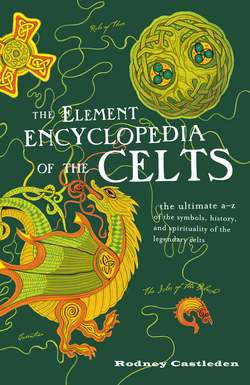Читать книгу The Element Encyclopedia of the Celts - Rodney Castleden - Страница 101
COINAGE
ОглавлениеThe Celts on the European mainland began minting coins in the fourth century BC, with designs based on Greek originals. Many of these found their way into Britain during the course of trading and eventually, in the first century BC, British kings began minting their own coins. This started in Cantium (Kent), with cast imitations of bronze coins of the Ambiana tribe across the Channel in northern Gaul.
Coins were made in surprisingly large numbers. It is said that from the middle of the La Tène period, they were minted by the million.
Pre-Roman Celtic coins sometimes have figurative images on them: representations of animals or people. These are evidently heavily symbolic. Some coins show a boar, and this is a motif on other objects too, such as the Witham shield made in the second century BC. It is also thought that coins had a special role as largesse and as an indicator of wealth, which would have made the imagery more potent.
A Gaulish coin found near Maidstone shows a stag and a boar running together. The stag has a huge eye and over-large antlers. The boar has over-large bristles. There are three different circular symbols, one of which may represent a rayed sun.
Coins of the Aulerci Eburovices tribe, who lived in the Evreux region in Gaul, show a boar image superimposed on the neck of a manlike image. This has a link with a similar pairing on a stone carved from Euffigneix: a human figure wearing a torc, with a boar carved along its torso.
By AD 10, the Camulodunum mint was turning out magnificent gold coins inscribed in full with name of the king, CVNOBELINVS. More often, kings contented themselves with an abbreviated form of their names and the names of their mints, so some coins had CVN and CAM (or CAMV) on them or CVN REX TASCIO F, “King Cunobelin, son of Tasciovanus.”
A British coin bearing King Cunobelin has the short form of his name on one side, CVNO, and the abbreviated name of his capital on the other, CAM for Camulodunum. The designs are admirably simple, compared with the fussy designs on modern coins.
The imagery on these coins sometimes tells us a lot about the tribal mindset. Cunobelin was setting out to be as Roman as could be. Other tribes portrayed totem images. Others went on imitating Gaulish coins, in ever-freer styles, so that the images became totally abstract. The head of Apollo was transformed into a swirl of hair. The image of a horse became more and more stylized until it was reduced to a few sweeping lines. The exploded horse image was already in existence in Britain, drawn on the chalk hillside at Uffington, and that had been there since the very beginning of the Iron Age, so the image was already available, and it is possible that the coin image was copied from it.
On the other hand, some northern tribes, such as the Parisii and the Brigantes, seem to have held back from engaging in the money economy and never struck any coins of their own.
